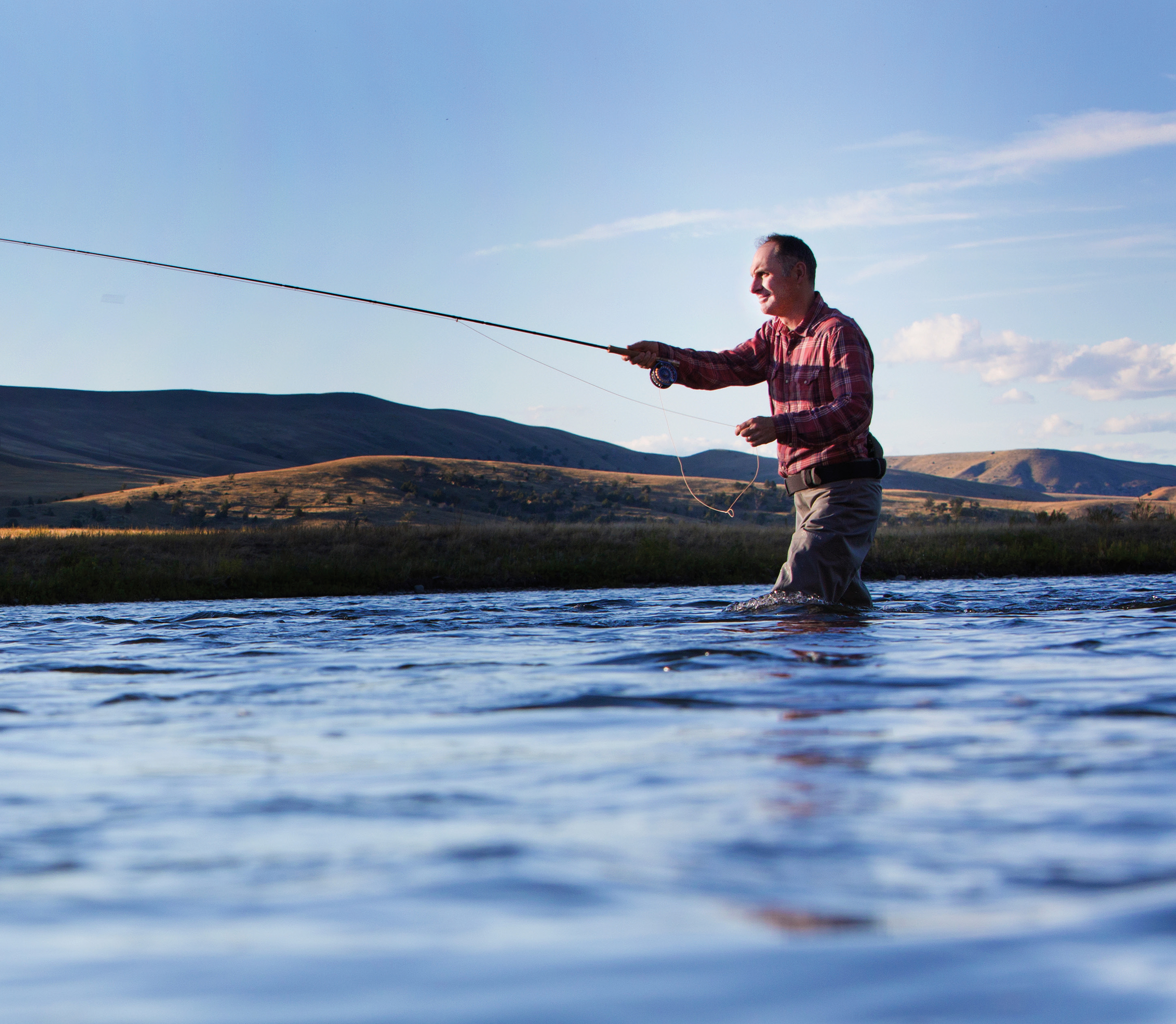
04 Feb From Scratch
I’m standing alongside the Gallatin River in Southwest Montana, stringing up my new custom rod. I’m careful taking it out of the tube, and I avoid putting it on the ground like I usually do for fear of getting it dirty. But truth be told, I’m in too much of a rush to take in its true beauty.
When I left the house, the sun was out, but now it’s chilly and the sky above is turning gray. Trying to hold onto summer, I’m committed to throwing a hopper. But I know that the daylight is slipping away, as is the warmth, so I’m chucking to the far bank with little regard for presentation. With each cast, I become more impatient until I reel it in and stumble upriver.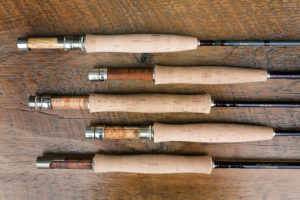
A bald eagle flies overhead, and as I watch it, I see the clouds rolling in and get a few snowflakes in my eyes. Then, fish start to rise about 15 feet in front of me. Taking my time now, I tie on a size-18 Blue Wing Olive and strip out line. I pick up the new rod again, false cast, then casting forward, I feel the line fly. I smile and a “whoa” slips past my lips.
That story started this past spring in a small workshop in Bozeman, Montana, that Tom Morgan Rodsmiths has called home for the past three years. I’ve bought a lot of fly rods over the years, but walking into this space isn’t like grabbing a rod off the shelf or ordering one online at midnight after one too many scotches.
Inside, I sit down with co-owners Matt Barber and Joel Doub and tell them what I’m looking for: a classic trout fly rod, something that walks the line between delicate and powerful. Barber and Doub nod and pull out their custom order form. Because I travel a good amount, I go with a four-piece, 9-foot, 5-weight graphite in classic red with a Wells grip. After sorting out a few other details, the guys tell me I’ll have my rod by the end of summer.
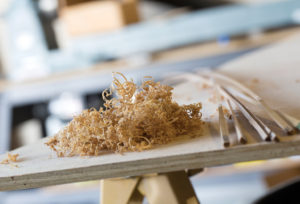
Bamboo shavings and strips from a custom bamboo rod.
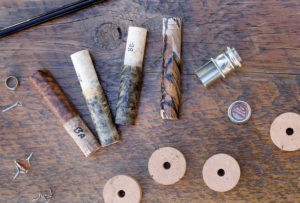
A display of custom-made hardware, including agate stripping guides, shop-cut reel seats, a nickel silver butt cap, and shop-drilled fine Portuguese cork rounds.
The reason for the wait has to do with the man who gave his name to the company. Tom Morgan grew up guiding anglers in Ennis, Montana. After buying what he considered a sub-standard rod from the R.L. Winston Rod Company in San Francisco, he later bought that business and moved it to Montana. As owner and rod designer from 1973 to 1991, he created the accurate, smooth action rods for which the company is still known.
Shortly after selling Winston, Morgan was diagnosed with multiple sclerosis, but that didn’t deter him from his passion for building fly rods. By 1994, when he started Tom Morgan Rodsmiths, he was wheelchair-bound and almost completely paralyzed. Working with his wife Gerri Carlson — who had never made a rod before — he guided her through every step of the process. Soon, the high-quality, small-batch rods they created in their home-based workshop were some of the most sought after, with sales gaining momentum from stories that ran on ESPN and in other media outlets.
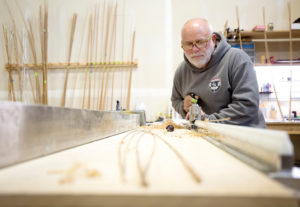
Ric Plante uses the Morgan Handmill to plane bamboo for a custom fly rod.
Twenty years later, with Morgan’s health deteriorating further, the couple put the company on the market. Offers came from large companies and investors who wanted to use Morgan’s name for mass-market rods or move the company and production out of state, but these overtures didn’t appeal to them. Meanwhile, down in Denver, Barber, a middle school principal, and Doub, a surgical device salesman, were ready to make a change.
“We both had young families and felt like we were spinning our wheels,” Barber says. “We wanted to feel more connected to our jobs and work more with our hands.” Looking for a place that was close to fishing and skiing, they traveled to Bozeman, and discovered that the custom rod company was for sale.
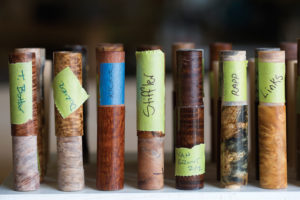
Custom burl wood reel seats are ready to be placed on their individual rods.
After getting to know Morgan and Carlson, it wasn’t long before Barber and Doub — who had built a combined total of zero rods between them — proposed buying the company, stipulating that they’d keep the name, remain in Bozeman, and retain the production quality and limited numbers. After gradually learning each step of the process to Morgan and Carlson’s satisfaction, Barber and Doub bought the company shortly before Morgan died in June 2017.
Along with keeping Morgan’s name, his employees, and almost all of his equipment, Barber and Doub also adopted his unique building philosophy. “We start with the finest tip possible, then create a constant progressive taper — a slope that’s constant from the tip to the butt,” Barber says. “Built for power and distance, modern rods usually have one rate of taper for the tip, but a stiffer one for the butt. Tom’s design means that when you need a rod to be delicate, it’s delicate, and when you need to step on it, well, it can do that too.”
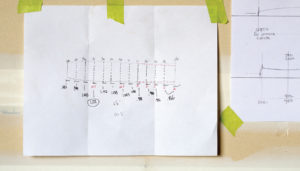
Custom specs for a cork handle are sketched out by hand.
The process starts with blanks that are made from a proprietary design encompassing the mandrel, pattern, and material — the combination of which delivers the specific action for which the company is known. Like all parts that aren’t made in-house, the blanks go through a thorough quality check and are then coated to the customer specifications — either red in color or clear.
Next, each blank’s deflection — how much it bends — is tested. If it falls in a small range of a graph, the blank is accepted and paired with another tip or butt with similar deflection. If it is outside of the accepted deflection range, the blank is thrown away. “This keeps our rod actions consistent,” Barber explains.
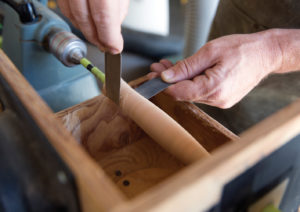
A cork handle is handshaped on a lathe.
After being straightened, if needed, on one-of-a-kind tools that were built by Morgan, each rod is cut into pieces and ferruled so they all connect together tightly. Unlike most modern rods, which feature tip-over-butt designs, these rods use spigot ferrules. “Each spigot ferrule is unique, so it takes many hours to custom fit, but we believe it produces a smoothness of action that’s worth the time and the carpal tunnel that goes along with it,” Barber says.
Barber and Doub create handles from scratch out of rounds of premium cork with the right color and texture. “We stack each cork and drill each one to match the taper of the rod. And, using a tool created by Morgan, we glue the cork so that every piece is in tight contact with the blank,” says Barber. “This not only enhances the rod’s longevity, but that connection between the handle and the blank gives you the ultimate feel between the motion of the rod and your hand,” Doub adds.
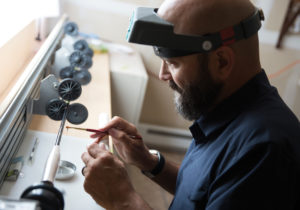
Co-owner Joel Doub brushes epoxy on wraps for strength and protection.
Because I feel like my hand always slides off my cigar-handled rods, for my new rod I’ve chosen a Wells-style handle, which is hand-lathed in the shop (customers can send in schematics or measurements of the exact size they want). This produces an unparalleled connection between the rod and its owner.
But I go one step further and come into the shop while they turn my handle on the lathe. It takes about 20 minutes and six different grits of sandpaper before the finished result conforms perfectly to my hand.
Save the cork, all the materials are sourced and manufactured in the U.S. from people who Barber and Doub know on a first-name basis. “First we look to our shop, then we look to Montana, then the West, and then the country,” says Barber about their sourcing philosophy. “We embrace other small craftsmen instead of buying from big conglomerates.”
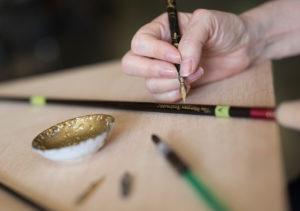
Personalized inscriptions are handwritten on the rods by a local calligrapher.
Before heading over to wrapping and calligraphy, the latter of which is done by a local Bozemanite, I have to decide on my inscription. Barber says they’ve seen it all, from “I love you Mom” and “Happy Retirement” to nothing at all. I think about some old baseball nicknames, maybe even Trout Slayer, before settling on something more classic: S. Camelio. Simple, clean — my youngest daughter’s name as well as my own, should she ever want the rod.
Attaching the guides to the rod using a fine thread — including the stripping guide, which is inlaid with agate (Montana’s official state gemstone) — takes about two hours, due to the attention to detail and the addition of brass wire for style. “Gerri was known for her wrapping,” says Doub. “We count each wrap to make everything consistent. We’re not eyeballing it. Measuring with calipers to the third decimal isn’t going to help you catch fish, but we were taught to do things one way: the right way.” Some wraps are purely decorative, like the 20-inch fish line, but others are structural, reinforcing the spigot ferrules and handle.

A variety of burl wood reel seats, reel locks, and cork handle styles.
Next, the wraps get five to seven coats of Flexcoat and sanding between each layer to get rid of any dust specks. “The consecutive layers give us a smoother finish with no bulges or tapers, creating a more beautiful rod,” Doub adds.
The reel seats are made in-house from wood chosen by the customer. Morgan obsessively bought up burls to have different colors and patterns to choose from. “People will also send us their own wood,” Barber adds. “Like the guy whose brother made wooden knives from a tree on a family ranch.”
Drawn to its swirls and ridges, with a dark line like a river running through it, I pick a spalted maple burl. And while most reel seats are flat, the guys mortise a slot in theirs. “It’s a pain in the butt, but Tom thought it gave you a better feel — and it does,” notes Doub.
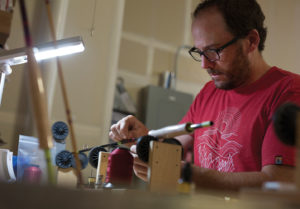
Co-owner Matt Barber wraps guides using their signature garnet thread.
Their customization process allows clients to choose from three reel-seat hardware options: uplock, downlock, and slide. The nickel silver hardware, which includes elaborate knurling and a company logo butt cap surrounded by a brass ring, gives off a high-quality feel. The last step is a buff and sanding for glue or imperfections, and then the rod is polished before it’s placed in the hand-stitched bag and powder-coated tube; in all, it includes parts from six different vendors.
“We got to modernize the design a little bit,” Barber says, explaining that a few changes have been made as the company has evolved.
“Quickly you have to make decisions that put your own flavor on things,” Doub adds. “We experiment with materials to find better flex profiles, but everything we do is to make Tom’s actions even purer.”
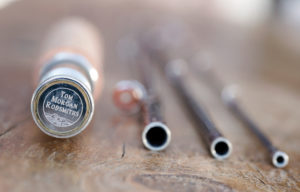
A brass ring surrounds the company logo on the nickel silver butt cap.
“For a long time everyone wanted instant gratification, and in fly rods that meant faster, stiffer, lighter,” Barber explains. But with the renewed interest in artisanal products like small batch whiskey and handmade shoes, the pendulum is shifting back to a focus on craftsmanship, quality, and the smooth action that Morgan’s designs deliver to those who take the time to learn how to use them.
After those first few casts, I get the “aha” moment when I realize I’m casting the rod and not the other way around. I can see the full arch with every trout I catch, and feel it with every cast — giving me that connection between man and rod, rod and nature, that every fly angler craves.
Later, I tell my buddy about all that went into the experience — the unique design, the different materials, the array of vendors, the hours of construction, the personalized touch. I tell him about the eagle, the blue wings, and the trout.
“So, what’s it like?” he asks.
“Worth the wait,” I say.




No Comments